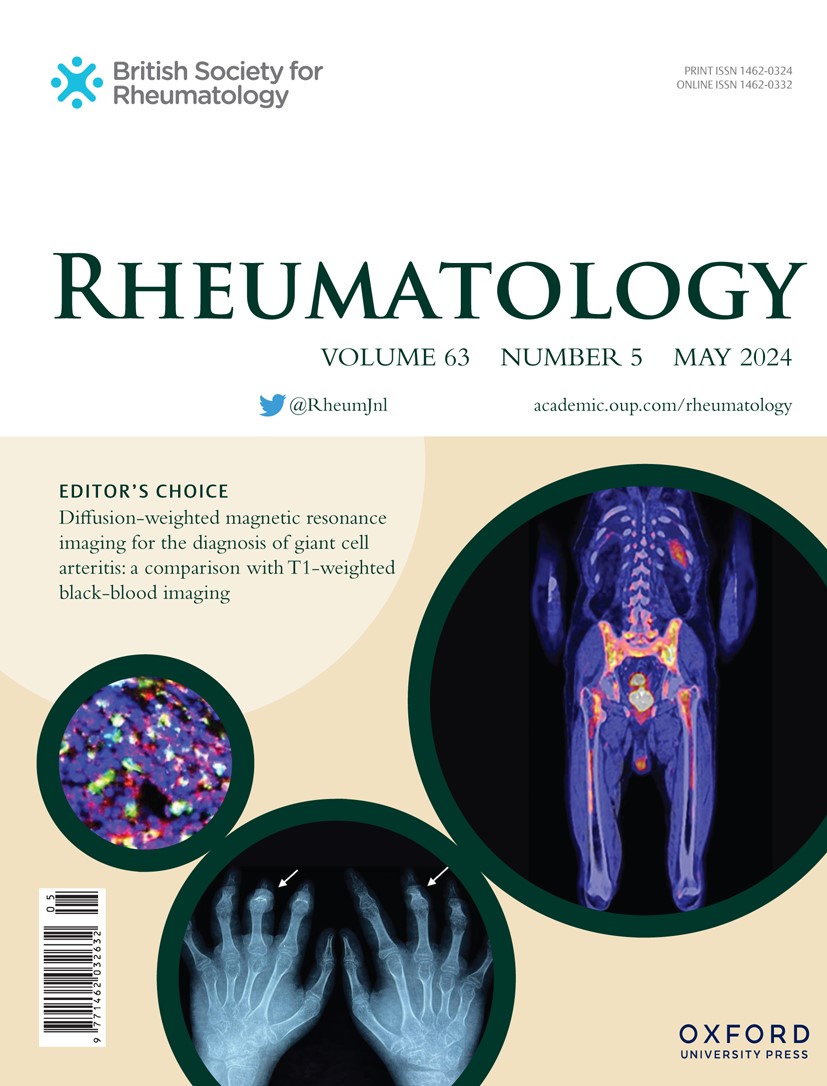Prognosis of essential mixed cryoglobulinemia and connective tissue disease-related cryoglobulinemia after rituximab-induced remission
IF 4.7
2区 医学
Q1 RHEUMATOLOGY
引用次数: 0
Abstract
Objectives Rituximab (RTX) and glucocorticoids are the first line treatment for essential (EM) and connective tissue disease (CTD)-related mixed cryoglobulinemia vasculitis (CryoVas). Data on long term outcomes of these CryoVas are lacking. We aimed to describe the prognosis of patients with EM and CTD-related CryoVas. Methods We conducted a retrospective study on patients with EM or CTD-related CryoVas in remission after RTX-based therapy. Results We included 63 patients with a median follow-up of 58 months (IQR, 33–88 months). Relapse rates were 23% at 1 year, 42% at 2 years and 71% at 5 years after the initial flare. In univariate analysis, factors associated with relapse were purpura (HR, 2.2; 95% confidence interval (CI), 1.1–4.4; p = 0.02) and a previous flare of CryoVas (HR, 1.9; 95% CI, 1.0–3.7; p = 0.04). Maintenance therapy was associated with a lower risk of early relapse (HR, 0.3; 95% CI, 0.1–0.9; p = 0.03), but not of late relapse (HR, 2.0; 95% CI, 0.7–5.7; p = 0.21). In multivariable analysis, patients without purpura or previous flare remained at lower risk of relapse than those with at least one of the two (HR, 3.6; 95%CI, 1.6–8.2; p= 0.002). Maintenance regimen was associated with a lower risk of early relapse (HR, 0.3; 95% CI, 0.1–0.9; p = 0.03). Conclusion In patients with EM and CTD-related CryoVas who received RTX as induction therapy, relapses were frequent and associated with purpura and a previous flare, but were reduced with maintenance therapy.利妥昔单抗诱导缓解后原发性混合冷球蛋白血症和结缔组织病相关冷球蛋白血症的预后
利妥昔单抗(RTX)和糖皮质激素是治疗原发性(EM)和结缔组织病(CTD)相关混合性冷球蛋白血症血管炎(CryoVas)的一线药物。这些CryoVas的长期结果数据缺乏。我们的目的是描述EM和ctd相关CryoVas患者的预后。方法我们对经rtx治疗后缓解的EM或ctd相关CryoVas患者进行了回顾性研究。结果纳入63例患者,中位随访58个月(IQR, 33-88个月)。复发后1年的复发率为23%,2年为42%,5年为71%。在单因素分析中,与复发相关的因素是紫癜(HR, 2.2;95%置信区间(CI), 1.1-4.4;p = 0.02)和先前的CryoVas耀斑(HR, 1.9;95% ci, 1.0-3.7;P = 0.04)。维持治疗与早期复发风险较低相关(HR, 0.3;95% ci, 0.1-0.9;p = 0.03),但晚期无复发(HR, 2.0;95% ci, 0.7-5.7;P = 0.21)。在多变量分析中,无紫癜或既往发作的患者复发风险低于至少有两者之一的患者(HR, 3.6;95%置信区间,1.6 - -8.2;p = 0.002)。维持方案与较低的早期复发风险相关(HR, 0.3;95% ci, 0.1-0.9;P = 0.03)。结论在接受RTX诱导治疗的EM和ctd相关CryoVas患者中,复发频繁,并伴有紫癜和既往发作,但维持治疗可减少复发。
本文章由计算机程序翻译,如有差异,请以英文原文为准。
求助全文
约1分钟内获得全文
求助全文
来源期刊

Rheumatology
医学-风湿病学
CiteScore
9.40
自引率
7.30%
发文量
1091
审稿时长
2 months
期刊介绍:
Rheumatology strives to support research and discovery by publishing the highest quality original scientific papers with a focus on basic, clinical and translational research. The journal’s subject areas cover a wide range of paediatric and adult rheumatological conditions from an international perspective. It is an official journal of the British Society for Rheumatology, published by Oxford University Press.
Rheumatology publishes original articles, reviews, editorials, guidelines, concise reports, meta-analyses, original case reports, clinical vignettes, letters and matters arising from published material. The journal takes pride in serving the global rheumatology community, with a focus on high societal impact in the form of podcasts, videos and extended social media presence, and utilizing metrics such as Altmetric. Keep up to date by following the journal on Twitter @RheumJnl.
 求助内容:
求助内容: 应助结果提醒方式:
应助结果提醒方式:


